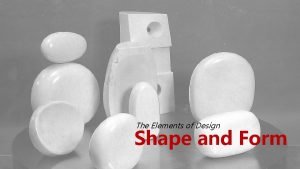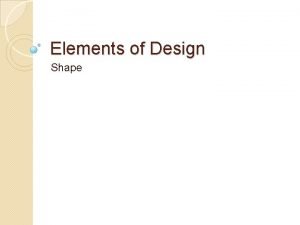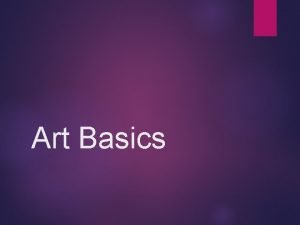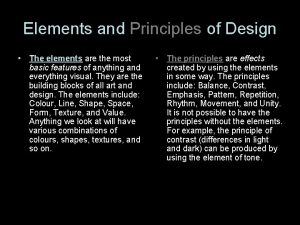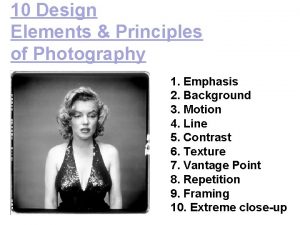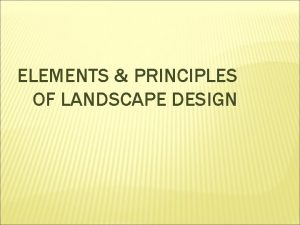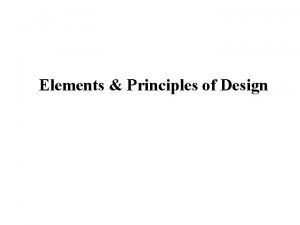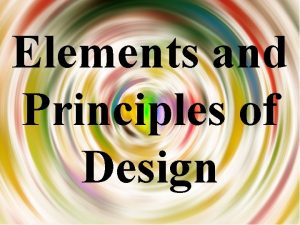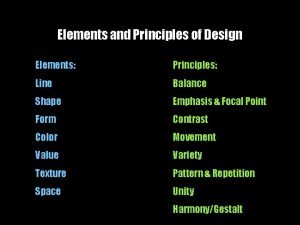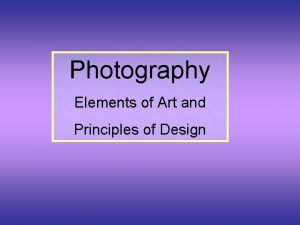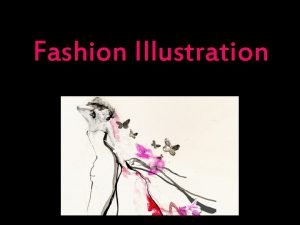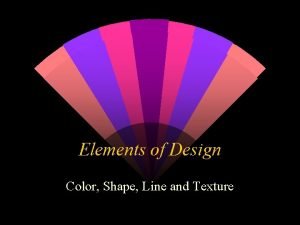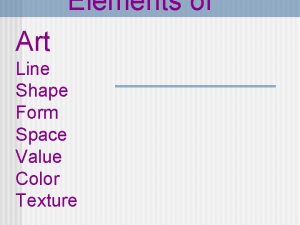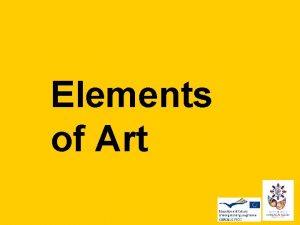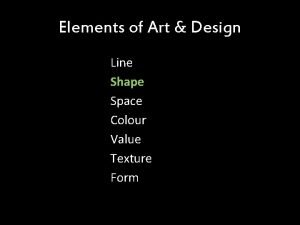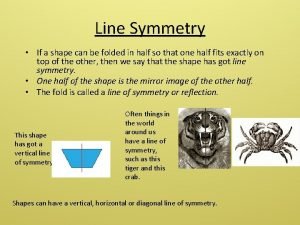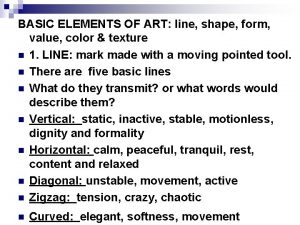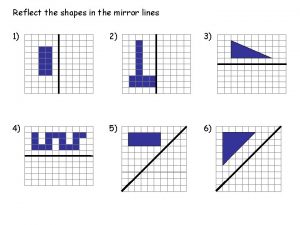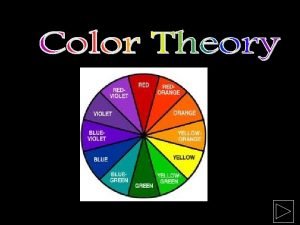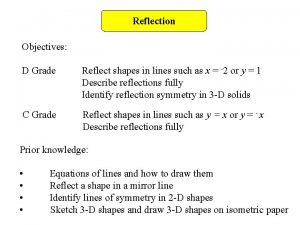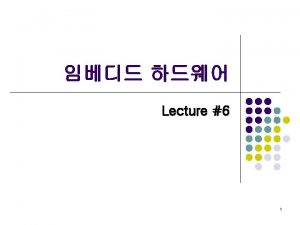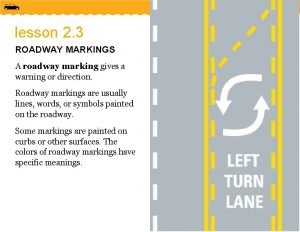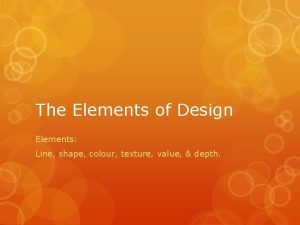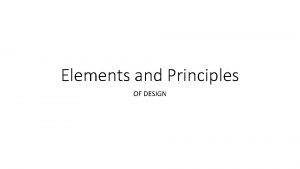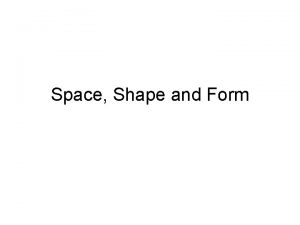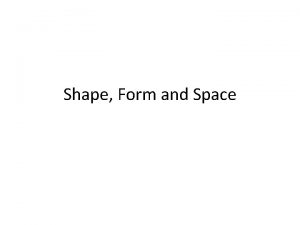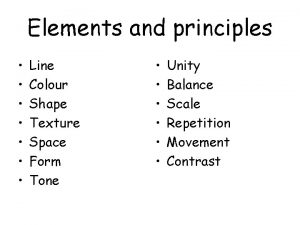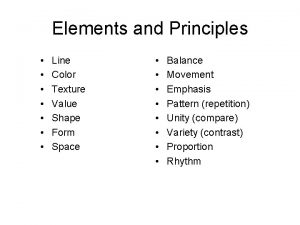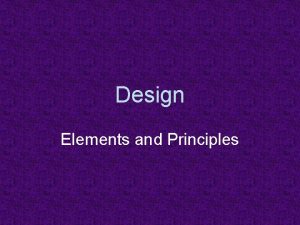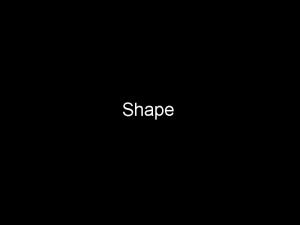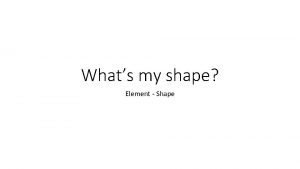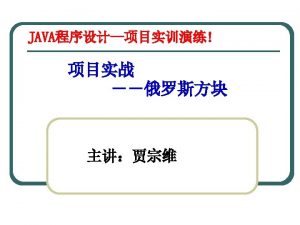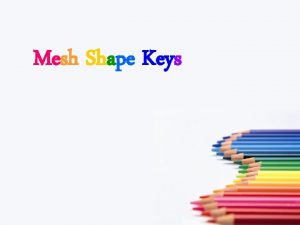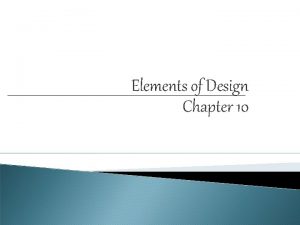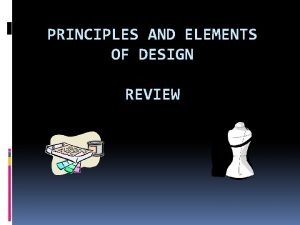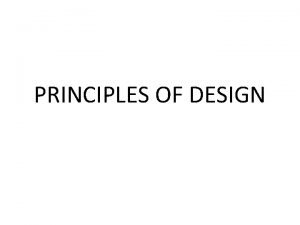Principles and Elements of Design Elements Line Shape




































- Slides: 36

Principles and Elements of Design

Elements • Line • Shape • Form • Space • Colour • Value • Texture Principles • Rhythm • Movement • Balance • Proportion • Pattern • Emphasis • Unity

Elements of art: The building blocks of visual art Principles of art: use or arrangement of the building blocks of visual art Composition: the organization of the elements of art according to the principles of art.

Composition




Elements of Art

Line • the path of a point moving through space _____________

Shape • A twodimensional area that is defined in some way

Form • Objects having three dimensions (height, width, depth) • Ex. Cubes, cylinders, spheres

Shape vs Form

Space • Space refers to the area in which art is organized. Perspective is representing a volume of space or a 3 -dimensional object on a flat surface.

Colour • Colours all come from the three primaries and black and white. They have three properties – hue, value, and intensity.

Value • Value refers to relative lightness and darkness and is perceived in terms of varying levels of contrast

Texture • Texture refers to the tactile qualities of a surface (actual) or to the visual representation of such surface qualities (implied).

Principles of Design

Rhythm • Indicates movement by a repetition of elements

Movement • Used to create the look and feeling of action and to guide the viewer’s eyes throughout the artwork

Balance • Concerned with equalizing visual forces, or elements, in a work of art.

1. Formal or Symmetrical: • Elements are equally distributed in mirror image

2. Informal or Asymmetrical: • Balance is visual; a more dynamic and interesting arrangement. Weight is usually distributed unevenly throughout the piece.

3. Radial: • Elements radiate from a central point

Proportion • Proportion is the size relationship of parts to a whole and to one another.

Pattern • Pattern refers to the repetition or reoccurrence of a design element, exact or varied, which establishes a visual beat.

Emphasis • Makes one part of the work more dominant than the other parts

Unity • Unity is achieved when the components of a work of art are perceived as harmonious, giving the work a sense of completion.

Quiz Time! Which Elements and Principles do we see in these works of art?

Edgar Degas, The Absinthe Drinker, 1876 o/c

Vincent Van Gogh. Starry Night. 1889 o/c

Franz Marc. The Yellow Cow, 1911 o/c

Pablo Picasso. Daniel-Henry Kahnweiler, 1910 o/c

Marcel Duchamp. Nude Descending a Staircase, No. 2, 1912

Meret Oppenheim. Object 1936 fur covered cup, saucer and spoon

Kaohsiung (TW) Rubber Duck 2013 18 x 21 meters Inflatable, pontoon and generator

Fin
 Shape and form
Shape and form Shape matching and object recognition using shape contexts
Shape matching and object recognition using shape contexts Shape matching and object recognition using shape contexts
Shape matching and object recognition using shape contexts Elements of design shape
Elements of design shape Principle of surveying
Principle of surveying Element in hair
Element in hair Elements of hair design
Elements of hair design The arrangement of accents or design in a radial balance
The arrangement of accents or design in a radial balance Elements and principles of design chart
Elements and principles of design chart Elements of design in interior design ppt
Elements of design in interior design ppt This line represents calm, peace, and relaxation.
This line represents calm, peace, and relaxation. Art basics
Art basics Elements and principles of design fashion
Elements and principles of design fashion Elements and principles of design space
Elements and principles of design space Repetition or reoccurrence of a design element
Repetition or reoccurrence of a design element Rhythm stone
Rhythm stone Elements and principles of landscape design
Elements and principles of landscape design What are the elements and principles of design
What are the elements and principles of design Christina's world
Christina's world Visual elements and principles of design
Visual elements and principles of design Photography elements and principles of design
Photography elements and principles of design Elements and principles of design fashion
Elements and principles of design fashion Airfoil nomenclature
Airfoil nomenclature The line of a dress or the garment's overall shape
The line of a dress or the garment's overall shape Line shape and form
Line shape and form Color spectrum bent into a circle
Color spectrum bent into a circle Line shape form space color value texture
Line shape form space color value texture Symmetrical alphabets
Symmetrical alphabets Form
Form Reflect the shape in the mirror line
Reflect the shape in the mirror line Form shape and space
Form shape and space Line of reflection
Line of reflection Bit lines
Bit lines Prologue in romeo and juliet act 1
Prologue in romeo and juliet act 1 Red raised roadway markers
Red raised roadway markers Of simulation and dissimulation summary
Of simulation and dissimulation summary Vibrating line in maxilla
Vibrating line in maxilla
